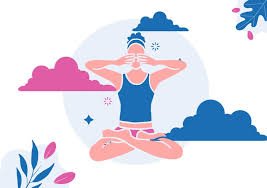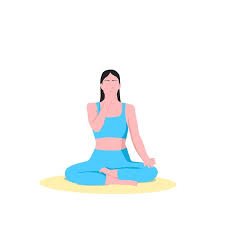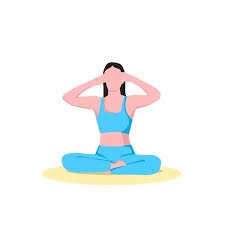Unlock the power of breath - Pranayama 101
Pranayama - you may of heard of this term, but maybe you don’t exactly know what it is. There are many different translations of this sanskrit word, but here is a simplified one: Prana - means life energy, Yama - means control. So it is the practice of controlling your life energy through breathing - got it?
Now that’s covered, you’re probably wondering HOW to practice pranayama, is it diffuclt? Are there any requirements? And the answer to both of those questions is no, or at least not always.
Everyone can practice some form of pranayama, but the real conversation is WHY you should practice. Breathing is usually involuntary, meaning it’s something we just do without thinking. Our modern busy day lives have made us breathe sharper and shorter breaths usually keeping the breath in our chest and shoulder region, which does the job for keeping us alive but it doesn’t do as much good for the body as slower and controlled breaths can. If we invite better prana (energy) into the body via our breath, we help lower blood pressure, lower heart rate, improve circulation, promote a sense of clarity, bring purified oxygen into the blood stream and so much more.
So now you know how powerful controlled breathing can be - here are 3 beginner pranayama exercises to introduce you to the practice of breath work.
1) Ujjayi Pranayama
Ujjayi Pranayama is the breath typically used during yoga classes, it is when you inhale through the nose and exhale through the nose OR through slightly parted lips in a sighing motion. Ujjayi helps to bring awareness to the body, soothes the nervous system, relieves insomnia, enhances focus and energises the body.
HOW TO DO UJJAYI: Take a deep inhale through your nose, and exhaling through the nose is you can. IF you can’t exhale via your nose or it doesn’t feel good for you, exhale in a sighing motion. Picture holding a mirror in front of you and you are trying to fog up the glass - that is the sound you should make when you exhale.
WHEN TO PRACTICE: Whenever and wherever you like, if you do a yoga class you will most likely practice this pranayama, but it is perfectly safe to practice at any point in the day. For a beginner, I would suggest no more than 10 rounds of ujjayi at a time.
RISK: If you have high or low blood pressure, I would not take such deep inhales and I definitely would not retain the breath inside as this could cause issues.
2) Nadi Shodhana
Nadi Shodhana is the practice of alternate nostril breathing. There are supposedly three energy channels in the body: the Ida Nadi (connected to the left side, feminine, moon & calm energy), the Pingala Nadi (connected to the right side, masculine, sun and active energy), and the Sushuma Nadi (the central energy channel, it connects us to the path of enlightenment). When we send the breath through alternate nostrils, we use all of these different Nadi’s and are bringing awareness to the different parts of ourselves. We are bringing inner peace, rejuvenating our nervous system and infusing our body with purified oxygen.
HOW TO DO NADI SHODHANA: In a seated position, place your left hand in gyan mudra (where thumb and 2nd finger touch), and with your right hand place your 2nd and 3rd finger down into your palm. Bring your right thumb to your right nostril and breathe out through the left. The pattern follows: inhaling left nostril, using the fingers on your right hand to close both nostrils to retain the breath, lifting the right thumb to exhale via the right nostril, then it is repeated on the other side so in on the right, retain, exhale left nostril. The ratio of inhale and exhale should be 1:2, so if you inhale for 3 seconds try to exhale for 6 seconds.
WHEN TO PRACTICE: I would recommend practicing this in the morning, as it gives you a clear and focused mind for the rest of the day. If you are a beginner, I recommend starting with 10 rounds at the most (5 rounds on each side), or if you lose count I would time yourself for no more than 2 minutes.
RISK: If you have a lung condition like COPD or asthma, doing this for prolonged periods of time may be dangerous. I would suggest taking out the breath retention part and just focusing on inhaling and exhaling via alternate nostrils.
3) Bhramari Breathing
Bhramari or bumble bee breathing is the practice of bringing awareness to your inner voice as you close off the senses during this breathing practice. This is a great pranayama to practice if you suffer with migraines or hypertension. Bhramari breathing also helps with relieving anxiety, soothing the nervous system and cooling down the body.
HOW TO PRACTICE BHRAMARI: Preferably in a seated position, bring your hands up towards your face and gently use your thumbs to close your ears and your other fingers to rest over your eyes. DO NOT push your fingers into your head and cause pain, it is a light touch to cover the ears and eyes. Breath in through your nose and breath out in a humming motion with your lips sealed. It should sound a bit like a bee buzzing, you should feel the vibrations inside of you.
WHEN TO PRACTICE: I would recommend a beginner to practice this in the morning before eating. BUT this pranayama is a great exercise to do at any point of the day if you start to feel anxious. I would do no more than 10 rounds if you are a beginner to this practice.
RISKS: If you have claustrophobia, you may not like this pranayama exercise so I would avoid. Again, if you suffer with high or low blood pressure proceed with caution and do not hold the breath for too long at a time.
Those are my three pranayama exercises I would recommend to a beginner who is interested in harnessing the power of their breath. Pranayama can be practiced at any point of the day, but I like to practice breath work as soon as I wake up as it keeps my mind clear for the rest of the day.
REMINDER - always know your own limits, if you struggle to take deep breaths or retain the breath in the body that is okay. These are merely suggestions if you are looking to start practicing pranayama .



